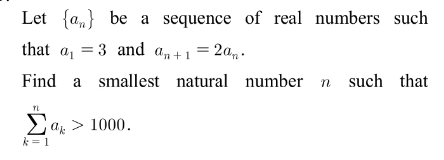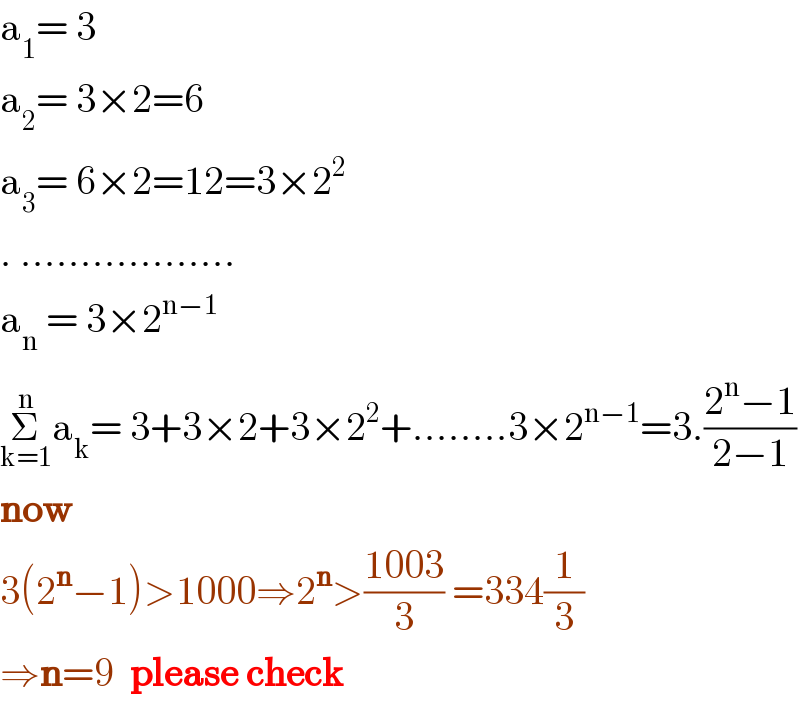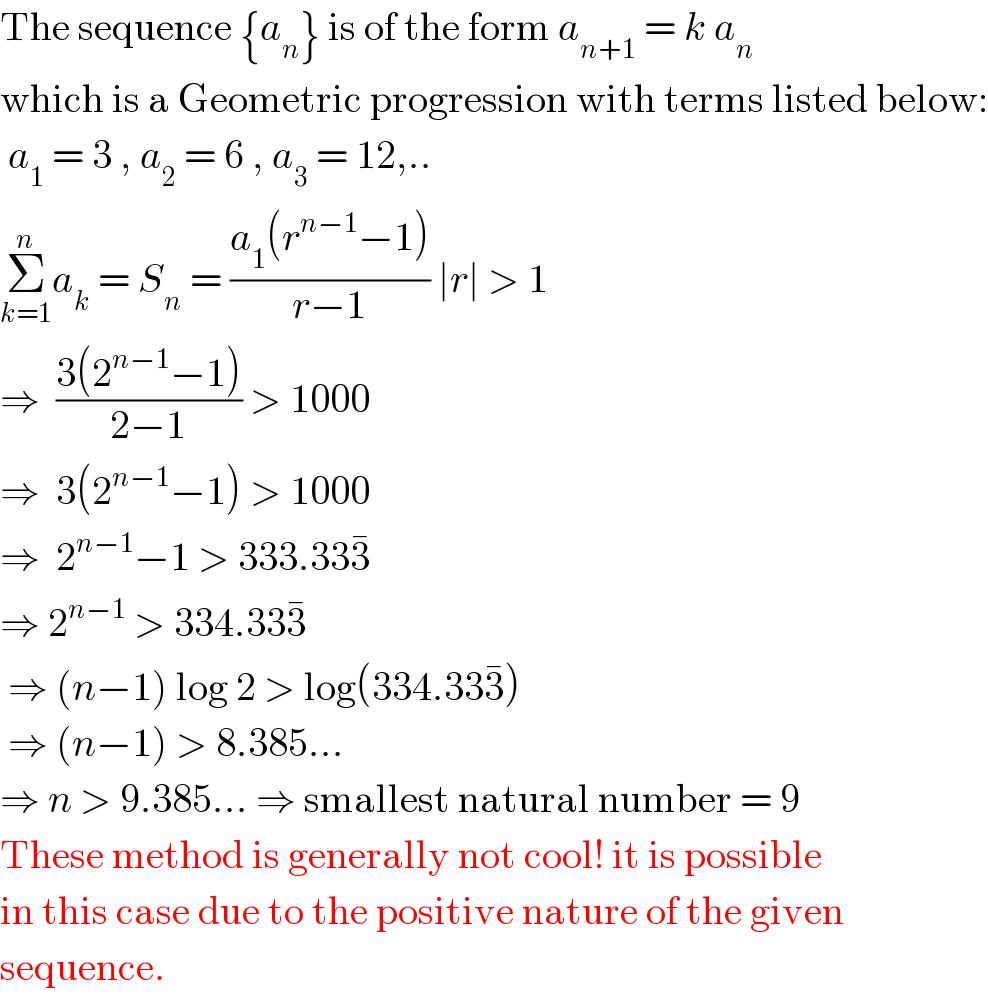Question Number 98690 by abony1303 last updated on 15/Jun/20

Commented by abony1303 last updated on 15/Jun/20

$$\mathrm{pls}\:\mathrm{help} \\ $$
Commented by PRITHWISH SEN 2 last updated on 15/Jun/20

$$\mathrm{a}_{\mathrm{1}} =\:\mathrm{3} \\ $$$$\mathrm{a}_{\mathrm{2}} =\:\mathrm{3}×\mathrm{2}=\mathrm{6} \\ $$$$\mathrm{a}_{\mathrm{3}} =\:\mathrm{6}×\mathrm{2}=\mathrm{12}=\mathrm{3}×\mathrm{2}^{\mathrm{2}} \\ $$$$.\:……………… \\ $$$$\mathrm{a}_{\mathrm{n}} \:=\:\mathrm{3}×\mathrm{2}^{\mathrm{n}−\mathrm{1}} \\ $$$$\underset{\mathrm{k}=\mathrm{1}} {\overset{\mathrm{n}} {\sum}}\mathrm{a}_{\mathrm{k}} =\:\mathrm{3}+\mathrm{3}×\mathrm{2}+\mathrm{3}×\mathrm{2}^{\mathrm{2}} +……..\mathrm{3}×\mathrm{2}^{\mathrm{n}−\mathrm{1}} =\mathrm{3}.\frac{\mathrm{2}^{\mathrm{n}} −\mathrm{1}}{\mathrm{2}−\mathrm{1}} \\ $$$$\boldsymbol{\mathrm{now}} \\ $$$$\mathrm{3}\left(\mathrm{2}^{\boldsymbol{\mathrm{n}}} −\mathrm{1}\right)>\mathrm{1000}\Rightarrow\mathrm{2}^{\boldsymbol{\mathrm{n}}} >\frac{\mathrm{1003}}{\mathrm{3}}\:=\mathrm{334}\frac{\mathrm{1}}{\mathrm{3}} \\ $$$$\Rightarrow\boldsymbol{\mathrm{n}}=\mathrm{9}\:\:\boldsymbol{\mathrm{please}}\:\boldsymbol{\mathrm{check}} \\ $$
Commented by abony1303 last updated on 15/Jun/20

$$\mathrm{Thank}\:\mathrm{you},\:\mathrm{sir}! \\ $$
Answered by Rio Michael last updated on 16/Jun/20

$$\mathrm{The}\:\mathrm{sequence}\:\left\{{a}_{{n}} \right\}\:\mathrm{is}\:\mathrm{of}\:\mathrm{the}\:\mathrm{form}\:{a}_{{n}+\mathrm{1}} \:=\:{k}\:{a}_{{n}} \: \\ $$$$\mathrm{which}\:\mathrm{is}\:\mathrm{a}\:\mathrm{Geometric}\:\mathrm{progression}\:\mathrm{with}\:\mathrm{terms}\:\mathrm{listed}\:\mathrm{below}: \\ $$$$\:{a}_{\mathrm{1}} \:=\:\mathrm{3}\:,\:{a}_{\mathrm{2}} \:=\:\mathrm{6}\:,\:{a}_{\mathrm{3}} \:=\:\mathrm{12},.. \\ $$$$\underset{{k}=\mathrm{1}} {\overset{{n}} {\sum}}{a}_{{k}} \:=\:{S}_{{n}} \:=\:\frac{{a}_{\mathrm{1}} \left({r}^{{n}−\mathrm{1}} −\mathrm{1}\right)}{{r}−\mathrm{1}}\:\mid{r}\mid\:>\:\mathrm{1} \\ $$$$\Rightarrow\:\:\frac{\mathrm{3}\left(\mathrm{2}^{{n}−\mathrm{1}} −\mathrm{1}\right)}{\mathrm{2}−\mathrm{1}}\:>\:\mathrm{1000} \\ $$$$\Rightarrow\:\:\mathrm{3}\left(\mathrm{2}^{{n}−\mathrm{1}} −\mathrm{1}\right)\:>\:\mathrm{1000} \\ $$$$\Rightarrow\:\:\mathrm{2}^{{n}−\mathrm{1}} −\mathrm{1}\:>\:\mathrm{333}.\mathrm{33}\bar {\mathrm{3}} \\ $$$$\Rightarrow\:\mathrm{2}^{{n}−\mathrm{1}} \:>\:\mathrm{334}.\mathrm{33}\bar {\mathrm{3}}\:\: \\ $$$$\:\Rightarrow\:\left({n}−\mathrm{1}\right)\:\mathrm{log}\:\mathrm{2}\:>\:\mathrm{log}\left(\mathrm{334}.\mathrm{33}\bar {\mathrm{3}}\right) \\ $$$$\:\Rightarrow\:\left({n}−\mathrm{1}\right)\:>\:\mathrm{8}.\mathrm{385}… \\ $$$$\Rightarrow\:{n}\:>\:\mathrm{9}.\mathrm{385}…\:\Rightarrow\:\mathrm{smallest}\:\mathrm{natural}\:\mathrm{number}\:=\:\mathrm{9} \\ $$$$\mathrm{These}\:\mathrm{method}\:\mathrm{is}\:\mathrm{generally}\:\mathrm{not}\:\mathrm{cool}!\:\mathrm{it}\:\mathrm{is}\:\mathrm{possible} \\ $$$$\mathrm{in}\:\mathrm{this}\:\mathrm{case}\:\mathrm{due}\:\mathrm{to}\:\mathrm{the}\:\mathrm{positive}\:\mathrm{nature}\:\mathrm{of}\:\mathrm{the}\:\mathrm{given} \\ $$$$\mathrm{sequence}. \\ $$
